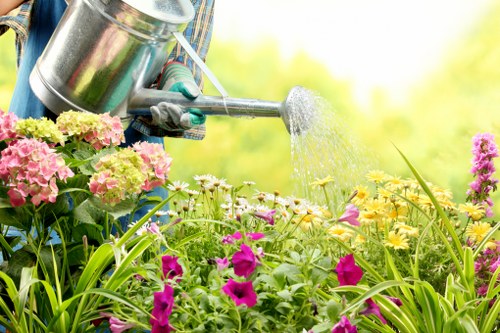Professional Tree Lopping and Removal Services in New Cross

Maintaining the health and aesthetics of your property in New Cross requires expert tree lopping and removal services. Whether you're dealing with overgrown branches, hazardous trees, or simply looking to enhance your landscape, professional arborists can provide the solutions you need.
Tree lopping involves the selective removal of branches to improve the tree's structure, health, and safety. It's a delicate process that requires knowledge and precision to avoid damaging the tree.
In cases where a tree poses a risk due to disease, storm damage, or structural weakness, tree removal becomes necessary. Removing a problematic tree ensures the safety of your property and the people around it.

Why Choose Professional Tree Services in New Cross?
Opting for professional tree lopping and removal services in New Cross offers numerous benefits. Experienced arborists bring expertise, the right equipment, and adhere to safety standards, ensuring the job is done efficiently and effectively.
Professional services also help in preserving the remaining trees on your property by ensuring that the removal or lopping process does not adversely affect their health.
Moreover, hiring certified tree service providers ensures compliance with local regulations, avoiding potential fines and legal issues.

Understanding Tree Lopping
Tree lopping is more than just cutting off branches. It involves a strategic approach to pruning that removes weak or unwanted branches while promoting healthy growth.
Proper lopping enhances the tree's appearance, reduces the risk of branch failure, and can increase sunlight penetration and air circulation around the tree.
Incorrect lopping, on the other hand, can lead to tree stress, disease, and a compromised structure, making professional expertise essential.

When to Consider Tree Removal
Tree removal should be considered in several situations, including:
- Dangerous Conditions: Trees affected by disease, pests, or structural issues pose safety risks.
- Property Damage: Fallen branches or leaning trees can cause significant property damage during storms.
- Development Projects: When clearing land for construction or landscaping projects.
- Overcrowding: Excessive trees can lead to overcrowded landscapes, impacting the health of remaining trees.
Assessing the need for removal with professional guidance ensures that the decision is based on sound reasoning and safety considerations.

The Tree Removal Process
Professional tree removal in New Cross follows a systematic process to ensure safety and efficiency:
- Assessment: Arborists assess the tree's health, structure, and the surrounding environment to determine the best removal strategy.
- Planning: A detailed plan is created, outlining the removal steps, equipment needed, and safety measures.
- Execution: Using specialized tools and equipment, the tree is carefully dismantled, minimizing impact on the property.
- Cleanup: All debris is removed, and the area is restored to its original condition or prepared for future landscaping.
Each step is crucial to ensure the tree removal process is carried out smoothly and safely.
Benefits of Tree Lopping and Removal
Engaging in tree lopping and removal offers several benefits:
- Safety: Eliminates hazardous trees and reduces the risk of property damage.
- Health: Promotes the overall health of trees by removing diseased or dead branches.
- Appearance: Enhances the visual appeal of your property by maintaining well-shaped trees.
- Property Value: Well-maintained trees can increase the value of your property.
- Environmental: Healthy trees contribute to better air quality and provide shade, reducing energy costs.
These advantages make tree lopping and removal essential for property maintenance and enhancement.
Choosing the Right Tree Service Provider
Selecting a reputable tree service provider in New Cross is crucial for achieving the best results. Consider the following factors:
- Experience: Look for companies with a proven track record in tree lopping and removal.
- Certification: Ensure the arborists are certified and trained in proper tree care techniques.
- Insurance: Verify that the company has adequate insurance to cover any potential damages.
- Equipment: The provider should have the necessary tools and machinery for efficient service delivery.
- Customer Reviews: Positive testimonials and reviews are indicators of reliable service quality.
Taking the time to research and choose the right provider ensures a satisfactory outcome.
Cost Factors in Tree Lopping and Removal
The cost of tree lopping and removal in New Cross can vary based on several factors:
- Tree Size: Larger trees require more effort and specialized equipment, increasing costs.
- Location: Accessibility to the tree affects the complexity of the removal process.
- Condition: Diseased or damaged trees may require additional steps, impacting the overall price.
- Services Required: Additional services like stump grinding or cleanup can add to the cost.
- Permits: Depending on local regulations, permits may be necessary, influencing the total expense.
Understanding these factors helps in budgeting and negotiating fair prices with service providers.
Safety Precautions in Tree Removal
Tree removal poses inherent risks, making safety precautions paramount. Professional arborists adhere to strict safety protocols, including:
- Proper Equipment: Using the right tools and protective gear to prevent accidents.
- Training: Ensuring all team members are trained in safe tree removal techniques.
- Planning: Assessing the site and developing a removal plan to mitigate risks.
- Stabilization: Securing the tree to control its fall direction and minimize impact.
- Weather Considerations: Avoiding removal during adverse weather conditions that could increase hazards.
Adhering to these safety measures ensures the well-being of both the workers and the property.
Environmental Impact of Tree Removal
While tree removal is sometimes necessary, it's essential to consider its environmental impact. Responsible arborists strive to minimize negative effects by:
- Sustainable Practices: Implementing methods that promote environmental sustainability.
- Debris Management: Properly disposing of or recycling tree remnants.
- Replanting: Encouraging the planting of new trees to replace those removed.
- Preservation: Retaining as many healthy trees as possible during the removal process.
Balancing the need for tree removal with environmental considerations preserves the ecosystem and maintains green spaces.
Tree Health Assessment
Before deciding on tree lopping or removal, a thorough health assessment is conducted. This evaluation includes:
- Visual Inspection: Checking for signs of disease, pests, or structural weaknesses.
- Soil Analysis: Understanding soil conditions that affect tree health.
- Growth Patterns: Assessing the tree's growth to identify any abnormalities.
- Environmental Factors: Considering external factors like weather and nearby structures.
Accurate assessments enable informed decisions, ensuring that actions taken are beneficial for both the tree and the property.
Legal Considerations in Tree Removal
Tree removal in New Cross is subject to local regulations and laws. It's essential to be aware of and comply with these legal requirements to avoid penalties:
- Permits: Certain tree removals may require permits from local authorities.
- Protected Species: Some trees are protected by law and cannot be removed without special permissions.
- Neighboring Properties: Considerations regarding the impact on adjacent properties must be addressed.
- Environmental Laws: Regulations aimed at preserving the environment may dictate the removal process.
Consulting with professional tree service providers can help navigate these legal aspects effectively.
Post-Removal Services
After tree lopping or removal, several post-service tasks ensure the area is left clean and presentable:
- Stump Grinding: Removing the tree stump to prevent regrowth and eliminate tripping hazards.
- Debris Cleanup: Clearing all branches, leaves, and wood pieces from the site.
- Soil Restoration: Repairing the soil to prepare for future landscaping or planting.
- Landscaping: Enhancing the area with new plants, grass, or decorative elements.
These services contribute to the overall improvement and maintenance of your property.
Choosing Sustainable Tree Removal Practices
Adopting sustainable practices in tree removal supports environmental conservation efforts. Key strategies include:
- Selective Logging: Removing only the necessary parts of a tree to maintain its overall health.
- Recycling Wood: Utilizing wood for mulch, firewood, or other purposes instead of discarding it.
- Replanting Initiatives: Planting new trees to replace those removed, ensuring continuous green coverage.
- Minimizing Waste: Efficiently managing debris to reduce environmental impact.
Implementing these practices helps preserve natural resources and promotes a healthier ecosystem.
Integrated Landscaping Solutions
Combining tree lopping and removal with comprehensive landscaping services can transform your property. Integrated solutions offer:
- Design Services: Professional design to create aesthetically pleasing landscapes.
- Plant Selection: Choosing appropriate plants that thrive in New Cross's climate.
- Maintenance Plans: Ongoing maintenance to ensure long-term landscape health.
- Hardscaping: Incorporating elements like pathways, patios, and fencing to enhance functionality.
These holistic approaches ensure that your outdoor space is both beautiful and sustainable.
Seasonal Considerations for Tree Care
Seasonal changes play a significant role in tree care. Understanding the best times for tree lopping and removal can optimize results:
- Spring: Ideal for planting new trees and conducting health assessments.
- Summer: Suitable for maintenance pruning to manage growth.
- Autumn: Effective for preparing trees before winter storms.
- Winter: Best for removal of dead or dormant trees.
Aligning tree care activities with seasonal cycles promotes tree health and reduces risks associated with adverse weather conditions.
Advanced Techniques in Tree Lopping
Modern arboriculture employs advanced techniques to ensure precise and effective tree lopping:
- Climbing Methods: Arborists use climbing gear to access high branches safely.
- Mechanical Equipment: Chainsaws, pruning shears, and cranes are utilized for efficient cutting and removal.
- Safety Harnesses: Protecting workers during elevated tasks.
- Respiratory Protection: Preventing inhalation of dust and debris during cutting.
These techniques enhance safety, efficiency, and the quality of the tree maintenance services provided.
Emergency Tree Services
Storms and unexpected events can cause sudden tree hazards. Emergency tree services in New Cross offer rapid response to:
- Storm Damage: Clearing fallen or broken trees that pose immediate dangers.
- Safety Hazards: Addressing trees that jeopardize property or personal safety.
- 24/7 Availability: Providing round-the-clock services to handle urgent tree removal needs.
Having access to emergency services ensures that tree-related emergencies are managed promptly and effectively.
Benefits of Regular Tree Maintenance
Regular tree maintenance through lopping and selective removal extends the lifespan of trees and maintains their structural integrity. Benefits include:
- Disease Prevention: Early detection and removal of affected branches reduce the spread of diseases.
- Pest Control: Managing infestations by removing infested parts.
- Structural Strength: Ensuring branches grow in a manner that supports the tree's stability.
- Enhanced Growth: Promoting healthy growth by removing excessive or competing branches.
Consistent maintenance fosters robust, healthy trees that contribute positively to your property's environment.
Cost-Effectiveness of Preventative Maintenance
Investing in regular tree maintenance can be more cost-effective in the long run by:
- Reducing Emergency Costs: Preventing the need for expensive emergency tree removals.
- Minimizing Repair Expenses: Avoiding damage to property through proactive care.
- Extending Tree Lifespan: Maintaining tree health reduces the frequency of large-scale removals.
Proactive maintenance ensures financial savings while maintaining the aesthetic and safety standards of your property.
Eco-Friendly Tree Removal Practices
Embracing eco-friendly practices in tree removal supports sustainability and environmental health:
- Biodegradable Materials: Using eco-friendly products in the removal process.
- Energy-Efficient Equipment: Utilizing machinery that minimizes carbon footprint.
- Habitat Preservation: Protecting wildlife during the removal process.
- Waste Reduction: Implementing strategies to minimize waste generated.
Adopting these practices aligns tree removal activities with environmental conservation goals.
Community Impact of Tree Services
Quality tree lopping and removal services contribute positively to the local community by:
- Enhancing Neighborhood Aesthetics: Well-maintained trees improve the visual appeal of the area.
- Promoting Safety: Reducing tree-related hazards enhances community safety.
- Supporting Local Economy: Hiring local services stimulates economic growth.
- Environmental Benefits: Healthy trees contribute to better air quality and climate regulation.
These contributions foster a healthier, more attractive, and economically vibrant community.
Modern Equipment in Tree Removal
Advancements in technology have revolutionized tree removal, making the process safer and more efficient:
- Cherry Pickers: Provide safe access to high branches without causing ground disturbances.
- Stump Grinders: Efficiently remove tree stumps, preventing regrowth and improving landscape appearance.
- Advanced Chainsaws: Powered for efficiency and safety during cutting operations.
- Cranes: Assist in maneuvering large tree sections, especially in confined spaces.
Utilizing modern equipment enhances the precision and safety of tree lopping and removal services.
Training and Certification of Arborists
Professional arborists undergo extensive training and certification to ensure high-quality services. Key aspects include:
- Formal Education: Courses in arboriculture, biology, and environmental science.
- Hands-On Training: Practical experience in tree care techniques and equipment handling.
- Certifications: Credentials from recognized bodies like the International Society of Arboriculture (ISA).
- Continuous Learning: Ongoing education to stay updated with industry best practices.
Certified arborists are equipped with the knowledge and skills to deliver superior tree lopping and removal services.
Client Satisfaction and Quality Assurance
Achieving high client satisfaction is a priority for professional tree services. Strategies include:
- Clear Communication: Understanding client needs and expectations.
- Detailed Quotes: Providing transparent pricing and service outlines.
- Timely Service: Completing projects within agreed timelines.
- Quality Control: Inspecting work to ensure it meets set standards.
- After-Service Support: Addressing any concerns or follow-up needs post-service.
These practices ensure that clients receive reliable and satisfactory tree care solutions.
Innovations in Tree Care
The tree care industry continually evolves with new innovations aimed at improving service delivery:
- Drone Technology: Assisting in tree assessments and monitoring.
- Eco-Friendly Products: Using sustainable materials in tree treatments.
- Smart Equipment: Integrating IoT and automation for efficiency.
- Advanced Plant Health Diagnostics: Utilizing technology for accurate tree health assessments.
Embracing these innovations enhances the effectiveness and sustainability of tree lopping and removal services.
Preparing for Tree Removal
Proper preparation is essential for a successful tree removal project. Steps include:
- Site Evaluation: Assessing the area for potential obstacles and safety hazards.
- Permitting: Securing necessary permits as per local regulations.
- Utility Checks: Ensuring there are no underground utilities near the tree.
- Communication: Informing neighbors about the planned removal to avoid disputes.
These preparations facilitate a smooth and efficient tree removal process.
Aftercare Following Tree Removal
Post-removal care ensures the area remains safe and aesthetically pleasing:
- Site Restoration: Repairing any damages caused during removal.
- Soil Treatment: Addressing soil conditions to support future plantings.
- Tree Replacement: Planting new trees to maintain environmental balance.
- Ongoing Maintenance: Providing care for new plantings and the surrounding landscape.
Comprehensive aftercare services enhance the long-term benefits of tree removal.
Common Tree Removal Challenges
Tree removal presents several challenges that require professional expertise to overcome:
- Access Restrictions: Limited access to the tree site can complicate removal efforts.
- Proximity to Structures: Trees near buildings or power lines require careful handling to prevent damage.
- Size and Height: Large or tall trees necessitate specialized equipment and techniques.
- Root Systems: Extensive roots can pose obstacles during the removal process.
Experienced arborists are equipped to manage these challenges effectively, ensuring safe and efficient tree removal.
Legal Liability and Tree Removal
Tree removal carries potential legal liabilities, making it essential to adhere to legal and safety standards:
- Property Damage: Ensuring that removal activities do not harm surrounding properties.
- Worker Safety: Complying with occupational safety regulations to protect workers.
- Permit Compliance: Following local laws regarding tree removal permits and regulations.
- Insurance Coverage: Having adequate insurance to cover potential liabilities.
Adhering to these legal aspects safeguards both the service provider and the client from potential disputes and liabilities.
Choosing Between Tree Lopping and Removal
Deciding whether to lop or remove a tree depends on various factors, including the tree's health, location, and the desired outcome:
- Health Condition: Diseased or structurally unsound trees are candidates for removal.
- Safety Concerns: Trees posing immediate safety risks are better removed than lopped.
- Aesthetic Goals: To enhance the tree's appearance, lopping may be sufficient.
- Space Requirements: If space is needed for new developments, removal might be necessary.
Consulting with a professional helps in making an informed decision tailored to your specific needs.
Final Thoughts on Tree Services
Professional tree lopping and removal services play a vital role in maintaining the safety, health, and beauty of your property in New Cross. By choosing experienced arborists, adhering to best practices, and considering environmental impacts, you ensure that your trees contribute positively to your surroundings.
Contact us today to schedule your tree lopping or removal service and enhance the landscape of your property.

